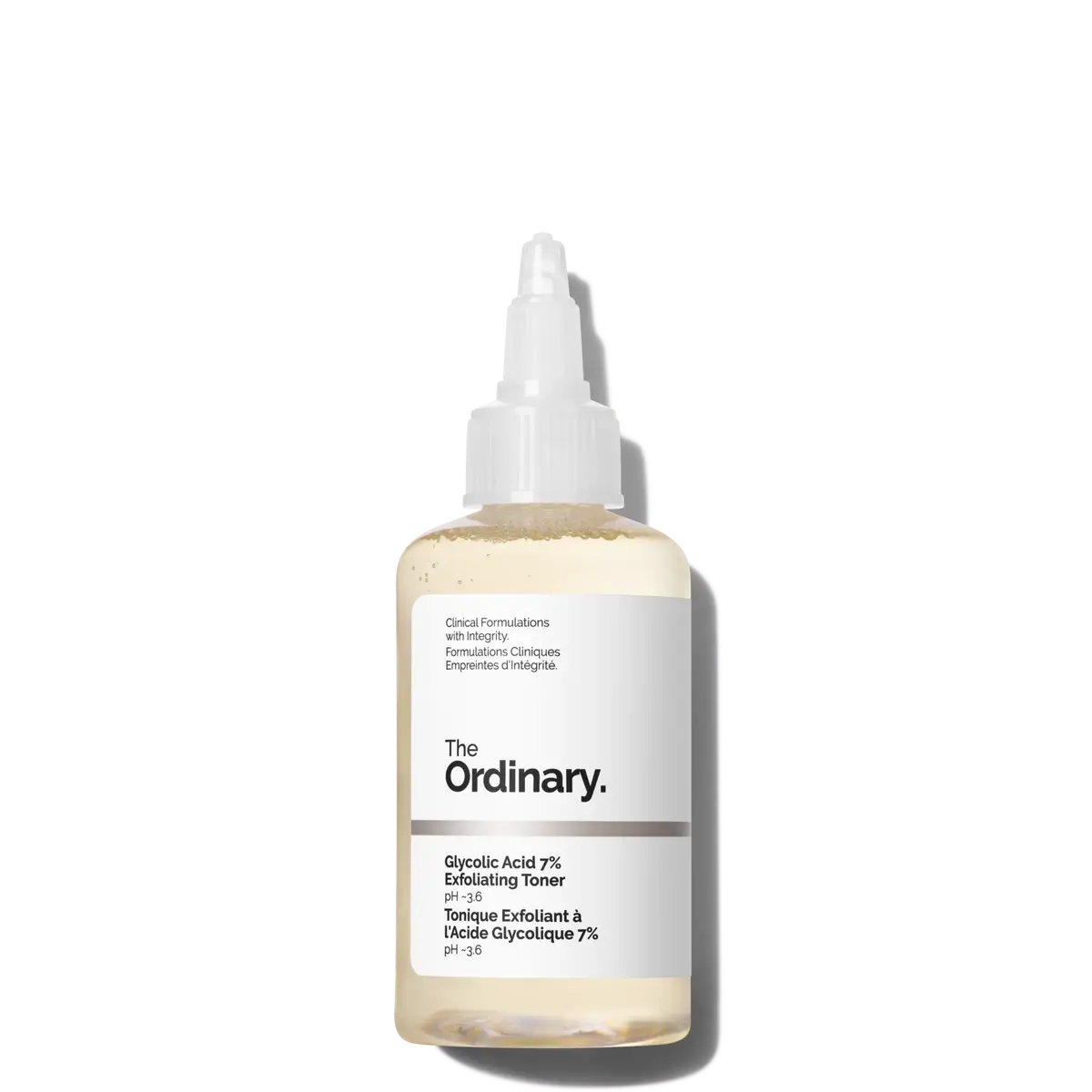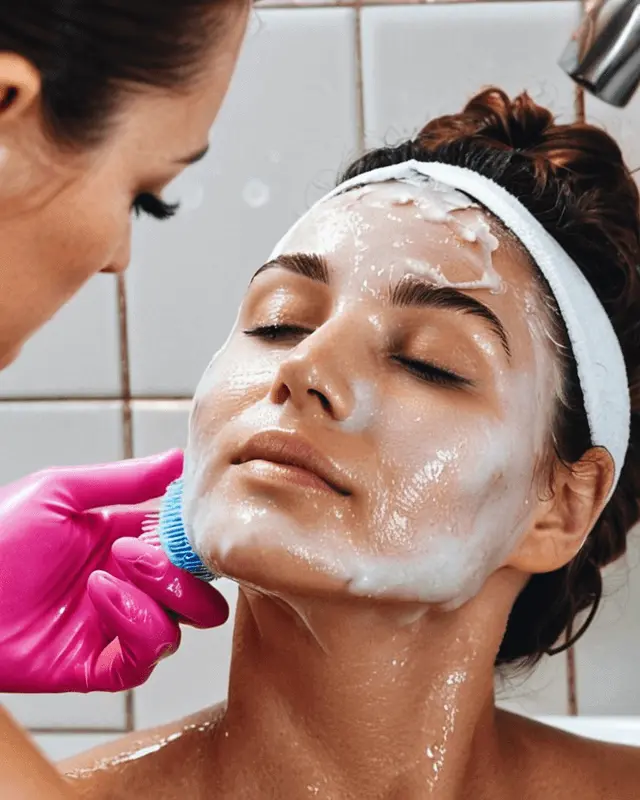The Ordinary Glycolic Acid 7% Toning Solution – Definitive And Best Guide!
Product Overview
Brand Background/Philosophy:
Ingredients in The Ordinary Glycolic Acid 7% Toning Solution

The Science Behind It:
- CosDNA analysis shows it contains mild irritants and rates its safety as “troubling.” EWG rates it a 3 (moderate hazard) due mainly to the glycolic acid content.
| Ingredient | Function | Acne | Irritant | Safety |
| Aqua | Solvent | 1 | ||
| Glycolic Acid | Exfoliator, Whitening | 1-4 | ||
| Rosa Damascena Flower Water | Skin conditioning | 1 | ||
| Centaurea Cyanus Flower Water | Skin conditioning | 1 | ||
| Aloe Barbadensis Leaf Water | 1-3 | |||
| Propanediol | Solvent, Viscosity Control | 1 | ||
| Glycerin | Solvent, Viscosity Control, Skin conditioning, and Moisturizer | 0 | 0 | 1-2 |
| Triethanolamine | pH Adjusters | 2 | 0 | 5 |
| Aminomethyl propanol | 1-3 | |||
| Panax Ginseng Root Extract | Skin conditioning, Plant extract, Emollient | 1 | ||
| Tasmannia Lanceolata Fruit/leaf Extract | Skin conditioning, Antioxidant | |||
| Aspartic acid | Antistatic, Moisturizer | 1 | ||
| Alanine | Antistatic, Moisturizer | 1 | ||
| Glycine | Skin conditioning | 1 | ||
| Serine | Antistatic, Moisturizer | 1 | ||
| Valine | Antistatic | 1 | ||
| Isoleucine | Antistatic | 1 | ||
| Proline | Antistatic, Moisturizer | 1 | ||
| Threonine | Antistatic | 1 | ||
| Histidine | Antistatic, Moisturizer | 1 | ||
| Phenylalanine | Antistatic | 1 | ||
| Glutamic Acid | Antioxidant | 1 | ||
| Arginine | Antistatic, Skin conditioning, Moisturizer | 1 | ||
| PCA | Moisturizer | 2 | ||
| Sodium PCA | Antistatic, Skin conditioning, Moisturizer | 0 | 0 | 1 |
| Sodium Lactate | pH Adjusters, Moisturizer, Exfoliator | 1-3 | ||
| Fructose | Moisturizer | 1 | ||
| Glucose | Moisturizer | 1 | ||
| Sucrose | Moisturizer | 1 | ||
| Urea | Antistatic, Skin conditioning, Moisturizer, Anti-inflammatory, Exfoliator | 1-3 | ||
| Hexyl nicotinate | Skin conditioning | 1 | ||
| Dextrin | Viscosity Control | 1 | ||
| Citric Acid | pH Adjusters | 1-2 | ||
| Polysorbate 20 | Surfactant, Emulsifier | 0 | 0 | 3 |
| Gellan gum | 1 | |||
| Trisodium Ethylenediamine Disuccinate | 1 | |||
| Sodium chloride | Viscosity Control | 0-3 | 1 | |
| Hexylene Glycol | Surfactant, Solvent, Emulsifier | 2 | 1 | 1 |
| Potassium Sorbate | Preservative | 2 | ||
| Sodium Benzoate | Preservative | 1-3 | ||
| Hexanediol | Solvent | 1 | ||
| Caprylyl Glycol | Moisturizer, Emollient | 1 |
How To Use

Routine Fit
Do not use it with
User Reviews
Performance According to Users
Most anecdotal reports are very positive, with many claiming it provides noticeable brightening, smoothing of bumpy texture, and fading of marks/acne scars within a few weeks of consistent use. Some state that it helps control oil and acne as well. Dryness is the main issue reported if overusing.
Dupes & Alternatives
Cost & Availability
Pros and Cons
Overall Rating
Questions You May Find Useful!
| People also Asked | Answers |
| How long does it take to see results with the ordinary glycolic acid? | Between one and six months – depending on your skin and skin cycle – your skin will be firmer and more elastic, and you might even notice a reduction in the appearance of scars. |
| What are the disadvantages of the ordinary glycolic acid? | Common side effects of GLYCOLIC ACID include dry skin, erythema (skin redness), burning sensation, itching, skin irritation, and skin rash. GLYCOLIC ACID can make the skin more sensitive in the sunlight, hence always use sunscreen and protective clothing before you step outdoors. |
| How many minutes should I leave glycolic acid on my face? | Type Concentration Duration of application Very superficial 30%–50% 1–2 minutes Superficial 50%–70% 2–5 minutes Medium-depth 70% 3–15 minutes |
| Can I use 7% glycolic acid every day? | It is OK to use 1-2% containing glycolic acid face wash or ointments daily. The creams have a higher glycolic acid content (10% and above) and must only be used once or twice a week to avoid skin irritation. The creams with a concentration above 15% may need to be kept only for a few minutes and then wiped off. |
| What are the side effects of the ordinary glycolic acid? | Side Effects of GLYCOLIC ACIDBurning sensation.Itching.Skin irritation.Swelling.Skin rash. |
| Does the ordinary glycolic acid remove dark spots? | One of the top benefits of glycolic acid is its remarkable ability to fade dark spots, age spots, and melasma. Hyperpigmentation mainly impacts the top layer of skin. When glycolic acid is applied, it removes and exfoliates the darkest skin cells to reveal fresh, more even-toned skin underneath. |
| Can the ordinary glycolic acid be used for underarms? | Many people on social media spotlight The Ordinary Glycolic Acid Solution as their go-to underarm treatment — you just soak a cotton pad and swipe it over the area — “but any facial product with less than 10% glycolic acid should be fine in terms of the irritation factor,” says LoGerf |
| Does glycolic acid help with armpit odor? | This is because glycolic acid possesses antibacterial properties. Furthermore, it serves as an exfoliant, sloughing off superficial dead skin cells and eliminating the bacterial load on the skin’s surface. This action may contribute to a reduction in underarm or body odor. |
| Can I use the ordinary glycolic acid on inner thighs? | Glycolic Acid can be used for dark areas on the skin,such as private areas and inner thighs. Glycolic Acid on feet help to break up rough skin. |
| How often should I use glycolic acid on my armpits? | A thin layer can be applied to dry underarms once daily. It’s important to allow the underarms to dry completely before lowering them. It is safe when used correctly but too high concentrations of glycolic acid, too much glycolic acid, or too frequent use can possibly lead to irritation, burns and pigmentation.” |
| How often should I use glycolic acid? | Two to three times a week as recommended. For starters, you can use glycolic acid two to three times a week. Apply it at night rather than during the day since glycolic acid increases your skin’s photosensitivity and makes it more susceptible to sunburn and damage. Once your skin has gotten used to the peel, you can begin to use it daily for the best results. |
| How long to use glycolic acid? | After about a month, you should notice clearer skin as glycolic acid works to keep skin clean and decongested. Two months in, you should see that dark spots and pigmentation is reduced as the regular glycolic acid application is melting away old, dead skin cells and increasing cell turnover. |







